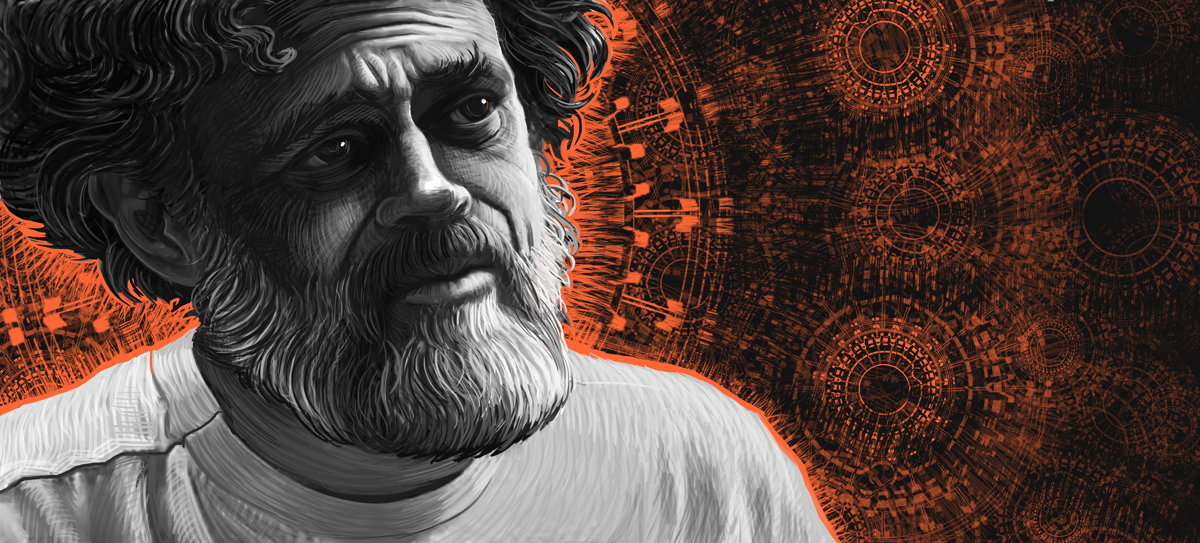Famed psychonaut Terence Mckenna envisioned a very radical approach of bridging psychedelics with virtual reality to create a supercharged version of consciousness in which language, or rather the meaning behind what we speak, could be made visual in front of our very eyes.
In Mckenna’s “cyberdelic” future of virtual reality, artists and the revival of art, would be at the forefront of innovation, according to a talk he gave to a German audience in 1991.
Does this not still ring true 25 years on? Are not computer programmers and virtual cartographers the modern artists who are pushing the boundaries of our understanding of reality and ourselves?
“In the cyberdelic future, artists will rule because the world will be made of art”
As our technology advances at an astronomical rate, we have seen ourselves retracting from the beauty and self-organizing complexities of nature – trading it instead for machines and computers with their raw materials ripped from the earth and reorganized in a series of ones and zeros, silicon and gold – that we have forgotten that it all comes from the precious resources that exist in the beauty of nature on this planet that we call home.
“The sharing of our dreams by at last applying tools – not toward warfare, but toward the dissolving of boundaries between people and nations, so that the real biological fact of a human community can show through,” said Mckenna. “If we’re able to do that, we will be able to fast-forward the cultural crisis, and we will be able through psychedelics and mass media and the distribution and control of the flow of information, actually be able to save ourselves and this world from ruin.”
For Mckenna, the ultimate goal of virtual reality would be to create a sort of alchemically linguistic philosopher’s stone – one that invokes the “logos,” or pure linguistic form, that transcends conventional language, and one that allows cybernauts to visually comprehend meaning beyond the written and spoken realm of words.
“My fantasy for virtual reality is to use it as a technology for objectifying language. Because you see if we could see what we meant when we spoke, it would be a kind of telepathy. The method that use to communicate now, small mouth noises moving through space as acoustical signals, and then the consulting of learned dictionaries – this is not a wide band of communication, and yet the whole world is held together by small mouth noises and their electronic transductions as radio, television and so forth.”
“So, what the cyperpunk generation holds out to the rest of us is a new kind of communication. A communication that is like telepathy because it’s seen with the eyes. And so then, it dissolves boundaries and unites us back into this tribal community that we feel such a need for.”
“The future lies in the realization of beauty – making it more and more explicit”
Inventor and advocate for the “stoned ape theory” – which states that the evolution and consciousness of modern man first began when the African continent dried-up, and primates were forced from their canopy-dwelling abodes to begin foraging for food on the Savannah, and in doing so, encountered the mind-altering Psilocybe Cubensis mushroom growing from the dung of large, grass-eating mammals – Mckenna was Timothy Leary’s unofficial successor in turning on a whole new generation to the possibilities of psychedelics throughout the 80s and 90s.
Almost all entrepreneurs in the tech industry, especially in Silicon Valley, have revealed that psychedelic compounds have played a crucial role in the development of new technology and innovation.
Indeed, even Steve Jobs stressed the importance of taking LSD for not only creative expression, but for expanding human consciousness as a society.
“Taking LSD was a profound experience, one of the most important things in my life,” Jobs said. “LSD shows you that there’s another side to the coin, and you can’t remember it when it wears off, but you know it. It reinforced my sense of what was important — creating great things instead of making money, putting things back into the stream of history and of human consciousness as much as I could.”
“So, it seems to me the way the cyberpunk or cybertech community can keep its compass pointed towards the real human future, is to always keep natural models in mind.”
Why is it that Silicon Valley, the startup community, and entrepreneurs in general are all convalescing towards psychedelics as a means to push beyond conventional reality – to return to the fractal composition of nature that self-organizes with such aesthetic beauty?
Is this level of natural mimicry being used to better the future of humans, or has it taken a back seat to big business, anonymous apps that serve no purpose, passing around a baby dolphin for a selfie until it dies, and videos of kittens on YouTube that we’ve completely lost the plot that Terence Mckenna was trying to convey?
For Mckenna, the goal of virtually reality should have been obvious from the start – to allow mankind to connect more intimately with one another and an “Archaic Revival” with the natural forces of the universe.
“This is to me what the computer and the virtual technologies all push toward – a kind of mirroring of our own souls – that what the agenda of cyberspace is is a kind of turning of the body inside-out, bringing the soul into visible manifestation in the world as a kind of internal, transdimensional object, and then turning the body into a freely-commanded object in the human imagination.”
“Our mental power to project imagery has become so powerful that now, only our real option is to break with the planet and head out into a cultural space defined by our dreams and by our machines”
It seems that only a shift in consciousness can propel us to use our technology for purposes other than destruction. No sooner have we split the atom, developed supercomputers, and in doing so have wreaked ecological hazard on our planet, that we are already looking to travel to distance planets, colonize the heavens while exploring distant stars, only to carry with us the same backward mentality that landed us in this environmental catastrophe on Earth in the first place.
So, what was Mckenna’s solution to this relatively modern perplexity? Simply put, “We have the power to make any change we want to change the world, but we have to change our minds, and that means better art and more psychedelics.”
Mckenna recognized the innate human tendency towards entropy, but his suggestion was to use virtual reality as a canvass for this type of destructive behavior, and that the Earth – the realm of the physical — should be kept as a preserve as means for our own survival.
“The future is a future of ultra-technology in a dimension that is split-off from what is called ‘the ordinary world,’” said Mckenna. “The ordinary world – the natural world – is maintained like a botanical garden or a natural preserve, and then the human imagination, which is this titanic, Promethean force that is loose in our species – it is free in a virtual reality to create all of the castles of the imagination.”
So, how is virtual reality being used today? There have been major steps in the medical field, in which technicians can use VR to map-out the body and determine the best course of treatment, and there are virtual simulators that allow us to travel to distant imaginary places in the cybersphere.
Read More: 8ninths offers brief escapes to the enchanting world of virtual reality
However, most of the technology is being used for more shallow, commercial and marketing purposes for consumerism, like meeting Sports Illustrated models in Virtual Reality, or scoping out your next dream vacation in the virtual world before actually visiting.
One proposed use for Virtual Reality as a treatment for depression shows a striking similarity to how psilocybin mushrooms function in breaking down the ego, and allowing one to see the self from an outside perspective. The technology calls for the creation of a virtual avatar of oneself in which users can navigate a virtual plane and see themselves as both the patient and the therapist.
The study, published by the Royal College of Psychiatrists, concluded that “interventions using immersive virtual reality may have considerable clinical potential and that further development of these methods preparatory to a controlled trial is now warranted.”
We have the technology. We have the resources. And we have the dream. We need only focus our attentions away from the commercial, money-obsessed ambitions and more towards a better understanding of ourselves and compassion towards others.
Terence Mckenna saw virtual reality as a means to revolutionize human interaction forever by finally allowing us to see ourselves naked, unambiguous, and with complete linguistic understanding that would be a type of telepathy readily available in the virtual world.
Mckenna died of a rare brain tumor in 2000 at the age of 53. His vision for a cyberdelic virtual reality is slowly being realized; however, his message had always been one of dissolving boundaries and expanding consciousness for the greater good.
He set the bar incredibly “high” for the cyber community, and he drove his point home with the following conclusion on virtual reality.
“Well then it seems to me the thing you want to become is naked linguistic intent – pure intent toward communication. And so by mapping the linguistic possibility onto a topological continuum, and then processing it through computers, we actually create a true mirror for our own mind. And so to look upon this and to share it with other people, is to participate in a true form of telepathy. And I think this true, boundary-dissolving telepathy unites us all into one family should be the goal of the cyberspatial community.”












